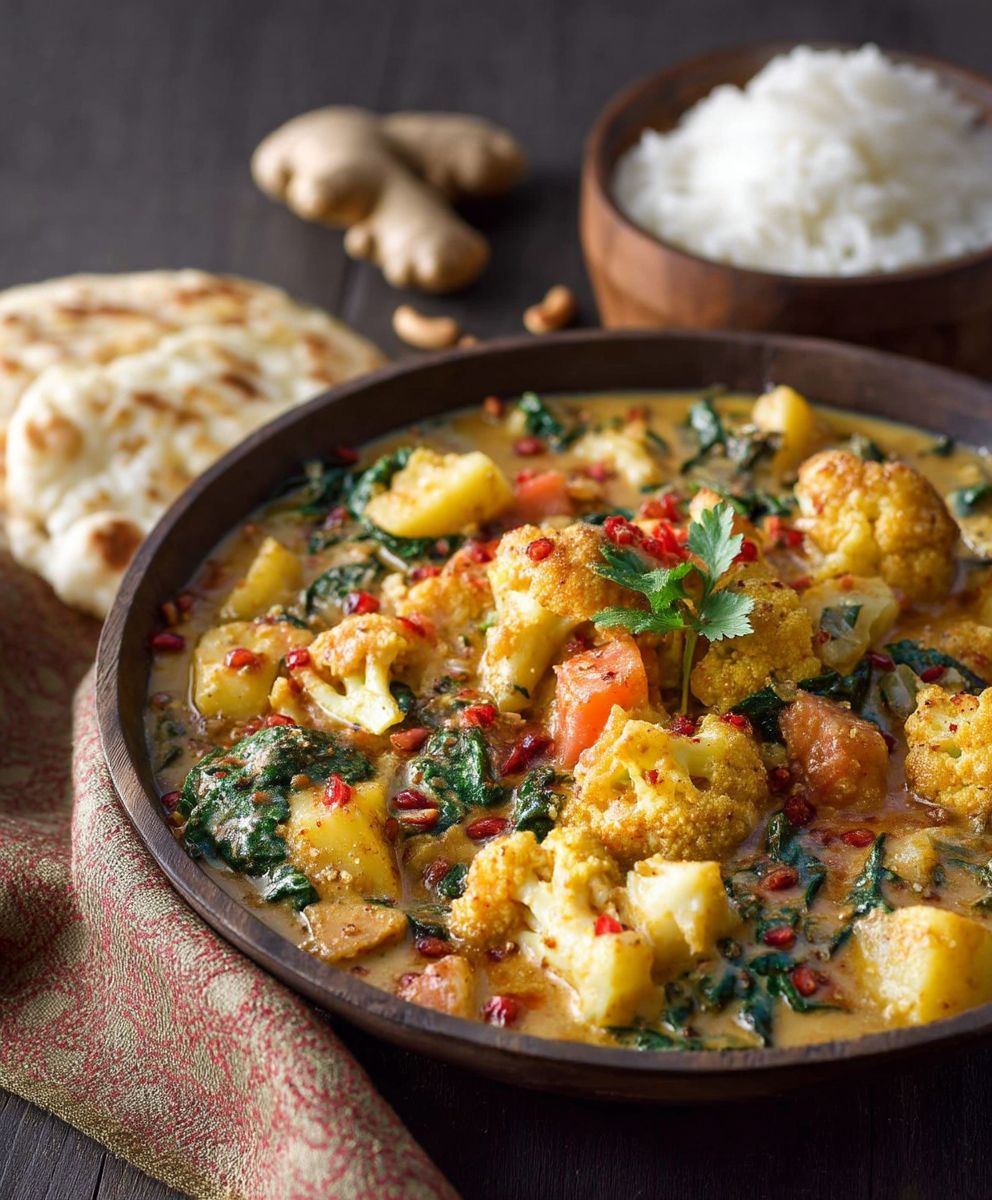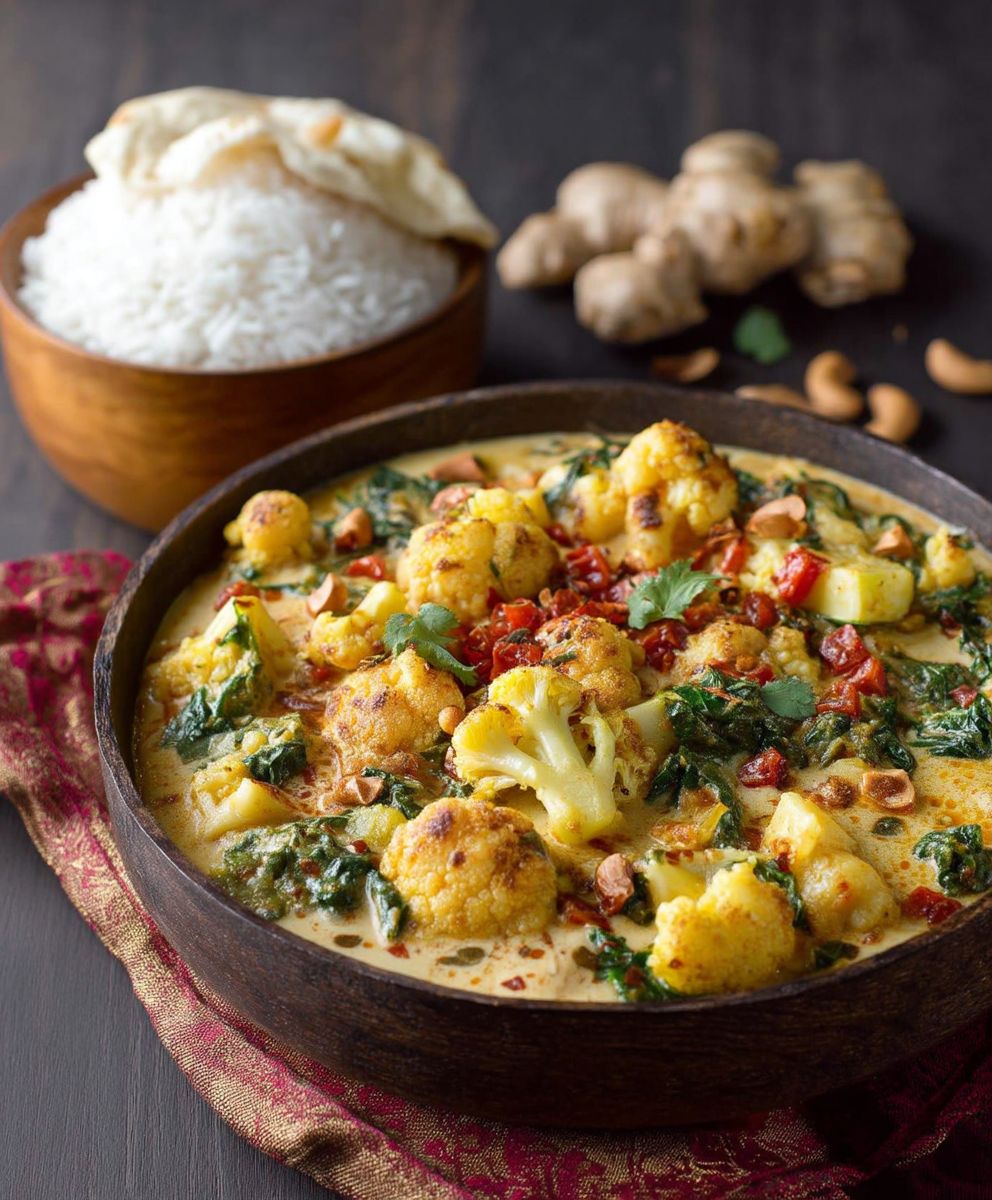Vegetable Korma, a symphony of creamy, spiced goodness, is about to become your new favorite weeknight dinner! Imagine tender, colorful vegetables bathed in a rich, aromatic sauce, a dish so comforting it feels like a warm hug on a chilly evening. Have you ever wondered how such a delectable dish came to be? Korma, with its roots tracing back to the Mughal Empire in India, was originally a dish fit for royalty. It was often prepared with meat, but the vegetarian version, Vegetable Korma, has gained immense popularity for its versatility and delightful flavors.
What makes this dish so irresistible? It’s the perfect balance of textures the slight crunch of the vegetables against the smooth, velvety sauce. The taste is an explosion of flavors, from the warmth of the spices to the subtle sweetness of the coconut milk or cream. And let’s not forget the convenience! You can easily adapt this recipe to use whatever vegetables you have on hand, making it a fantastic way to use up those odds and ends in your fridge. Get ready to embark on a culinary adventure as we unlock the secrets to creating the perfect Vegetable Korma, a dish that’s sure to impress your family and friends!
Ingredients:
- For the Vegetables:
- 1 tablespoon olive oil
- 1 large onion, chopped
- 2 cloves garlic, minced
- 1 inch ginger, grated
- 1 teaspoon ground cumin
- 1 teaspoon ground coriander
- ½ teaspoon turmeric powder
- ¼ teaspoon cayenne pepper (optional)
- 1 large potato, peeled and cubed
- 1 cup cauliflower florets
- 1 cup broccoli florets
- 1 cup green beans, trimmed and halved
- 1 cup carrots, peeled and sliced
- 1 cup frozen peas
- 1 (14.5 ounce) can diced tomatoes, undrained
- 1 cup vegetable broth
- Salt and pepper to taste
- For the Korma Sauce:
- 1 tablespoon olive oil
- 1 medium onion, chopped
- 2 cloves garlic, minced
- 1 inch ginger, grated
- 1 green chili, finely chopped (optional)
- 1 teaspoon garam masala
- ½ teaspoon ground cardamom
- ¼ teaspoon ground cinnamon
- ½ cup cashews, soaked in warm water for 30 minutes
- 1 cup coconut milk
- 2 tablespoons tomato paste
- 1 tablespoon lemon juice
- 2 tablespoons chopped cilantro, for garnish
Preparing the Vegetables:
- Heat the olive oil in a large pot or Dutch oven over medium heat. Add the chopped onion and cook until softened, about 5-7 minutes.
- Add the minced garlic and grated ginger to the pot and cook for another minute, until fragrant. Be careful not to burn the garlic.
- Stir in the ground cumin, ground coriander, turmeric powder, and cayenne pepper (if using). Cook for 30 seconds, stirring constantly, until the spices are fragrant. This step is crucial for blooming the spices and releasing their flavors.
- Add the cubed potato, cauliflower florets, broccoli florets, green beans, and sliced carrots to the pot. Stir well to coat the vegetables with the spice mixture.
- Pour in the diced tomatoes (undrained) and vegetable broth. Bring the mixture to a simmer, then reduce the heat to low, cover the pot, and cook for 15-20 minutes, or until the potatoes are tender. Check occasionally to ensure there’s enough liquid; add more broth if needed.
- Stir in the frozen peas and cook for another 5 minutes, until they are heated through. Season with salt and pepper to taste. Set aside while you prepare the korma sauce.
Making the Korma Sauce:
- While the vegetables are cooking, prepare the korma sauce. Heat the olive oil in a separate saucepan over medium heat. Add the chopped onion and cook until softened and lightly golden, about 7-10 minutes. This step is important for developing the sweetness of the onion.
- Add the minced garlic, grated ginger, and chopped green chili (if using) to the saucepan and cook for another minute, until fragrant.
- Stir in the garam masala, ground cardamom, and ground cinnamon. Cook for 30 seconds, stirring constantly, until the spices are fragrant.
- Drain the soaked cashews and add them to a blender or food processor. Add the coconut milk and tomato paste. Blend until smooth and creamy. This cashew cream is what gives the korma its rich and luxurious texture.
- Pour the cashew-coconut milk mixture into the saucepan with the spices. Stir well to combine. Bring the sauce to a simmer, then reduce the heat to low and cook for 5-7 minutes, stirring occasionally, until the sauce has thickened slightly.
- Stir in the lemon juice. Taste the sauce and adjust the seasoning as needed. Add more salt, pepper, or spices to your liking.
Combining and Serving:
- Pour the korma sauce over the cooked vegetables in the large pot or Dutch oven. Stir gently to combine, ensuring that all the vegetables are coated in the sauce.
- Simmer the vegetable korma over low heat for another 5-10 minutes, allowing the flavors to meld together. Stir occasionally to prevent sticking.
- Garnish with chopped cilantro before serving.
- Serve the vegetable korma hot with basmati rice, naan bread, or roti. You can also serve it with a dollop of yogurt or raita on the side.
Tips and Variations:
- Vegetable Options: Feel free to substitute or add other vegetables to the korma, such as sweet potatoes, spinach, mushrooms, or bell peppers.
- Nut-Free Option: If you have a nut allergy, you can substitute the cashews with sunflower seeds or pumpkin seeds. Soak them in warm water for 30 minutes before blending.
- Spice Level: Adjust the amount of cayenne pepper or green chili to control the spice level of the korma.
- Creaminess: For an even creamier korma, you can add a tablespoon or two of heavy cream or cashew cream at the end.
- Make Ahead: The vegetable korma can be made ahead of time and stored in the refrigerator for up to 3 days. Reheat gently before serving.
- Freezing: The korma can also be frozen for up to 2 months. Thaw overnight in the refrigerator before reheating.
Serving Suggestions:
- Serve with fluffy basmati rice for a complete and satisfying meal.
- Pair with warm naan bread or roti to soak up the delicious sauce.
- Add a side of raita (yogurt dip) to cool down the spice.
- Garnish with extra cilantro and a sprinkle of chopped nuts for added flavor and texture.
Nutritional Information (approximate, per serving):
- Calories: 350-450
- Protein: 10-15g
- Fat: 20-25g
- Carbohydrates: 30-40g
- Fiber: 5-7g
This vegetable korma is a flavorful and comforting dish that’s perfect for a weeknight dinner or a special occasion. Enjoy!

Conclusion:
And there you have it! This Vegetable Korma is more than just a recipe; it’s an invitation to experience a symphony of flavors and textures that will tantalize your taste buds and leave you craving more. I truly believe this is a must-try dish for anyone looking to add a touch of exotic elegance to their meals, whether you’re a seasoned chef or just starting your culinary journey.
Why is it a must-try? Well, beyond the sheer deliciousness, this recipe is incredibly versatile. It’s perfect for a weeknight dinner, yet sophisticated enough to serve at a dinner party. The creamy, fragrant sauce, infused with aromatic spices, envelops a medley of fresh vegetables, creating a harmonious blend that’s both comforting and exciting. Plus, it’s a fantastic way to sneak in extra veggies for even the pickiest eaters! The subtle sweetness of the coconut milk perfectly balances the savory spices, resulting in a dish that’s complex yet approachable.
But the best part? You can easily customize this Vegetable Korma to suit your preferences. Feel free to swap out the vegetables for your favorites cauliflower, green beans, or even sweet potatoes would be delicious additions. For a richer flavor, try using full-fat coconut milk. If you prefer a spicier kick, add a pinch of cayenne pepper or a finely chopped chili to the sauce. And for those who enjoy a bit of tang, a squeeze of lemon juice at the end will brighten up the flavors beautifully.
Serving suggestions are endless! I personally love serving this korma with fluffy basmati rice, allowing the sauce to soak in and create a truly satisfying meal. Naan bread is another excellent choice for scooping up every last drop of that delectable sauce. For a lighter option, you can serve it with quinoa or couscous. And if you’re feeling adventurous, try topping it with toasted almonds or cashews for added crunch and flavor. A sprinkle of fresh cilantro or parsley adds a vibrant touch of freshness.
Don’t be intimidated by the list of ingredients most of them are pantry staples, and the recipe itself is surprisingly easy to follow. I’ve broken it down into simple steps, so even beginner cooks can achieve restaurant-quality results. Trust me, the effort is well worth it! The aroma that fills your kitchen as this dish simmers is simply divine, and the first bite will transport you to a world of culinary bliss.
I’m so excited for you to try this recipe and experience the magic of Vegetable Korma for yourself. Once you do, I’d absolutely love to hear about your experience! Did you make any modifications? What vegetables did you use? What did you serve it with? Share your photos and stories in the comments below I can’t wait to see your creations! Happy cooking, and bon appétit! I am confident that this will become a regular in your meal rotation.
Vegetable Korma: The Ultimate Guide to Making Delicious Korma
A rich and creamy vegetable korma featuring a medley of colorful vegetables simmered in a fragrant cashew-coconut milk sauce. Perfect served with rice or naan!
Ingredients
- 1 tablespoon olive oil
- 1 large onion, chopped
- 2 cloves garlic, minced
- 1 inch ginger, grated
- 1 teaspoon ground cumin
- 1 teaspoon ground coriander
- ½ teaspoon turmeric powder
- ¼ teaspoon cayenne pepper (optional)
- 1 large potato, peeled and cubed
- 1 cup cauliflower florets
- 1 cup broccoli florets
- 1 cup green beans, trimmed and halved
- 1 cup carrots, peeled and sliced
- 1 cup frozen peas
- 1 (14.5 ounce) can diced tomatoes, undrained
- 1 cup vegetable broth
- Salt and pepper to taste
- 1 tablespoon olive oil
- 1 medium onion, chopped
- 2 cloves garlic, minced
- 1 inch ginger, grated
- 1 green chili, finely chopped (optional)
- 1 teaspoon garam masala
- ½ teaspoon ground cardamom
- ¼ teaspoon ground cinnamon
- ½ cup cashews, soaked in warm water for 30 minutes
- 1 cup coconut milk
- 2 tablespoons tomato paste
- 1 tablespoon lemon juice
- 2 tablespoons chopped cilantro, for garnish
Instructions
- Heat the olive oil in a large pot or Dutch oven over medium heat. Add the chopped onion and cook until softened, about 5-7 minutes.
- Add the minced garlic and grated ginger to the pot and cook for another minute, until fragrant. Be careful not to burn the garlic.
- Stir in the ground cumin, ground coriander, turmeric powder, and cayenne pepper (if using). Cook for 30 seconds, stirring constantly, until the spices are fragrant. This step is crucial for blooming the spices and releasing their flavors.
- Add the cubed potato, cauliflower florets, broccoli florets, green beans, and sliced carrots to the pot. Stir well to coat the vegetables with the spice mixture.
- Pour in the diced tomatoes (undrained) and vegetable broth. Bring the mixture to a simmer, then reduce the heat to low, cover the pot, and cook for 15-20 minutes, or until the potatoes are tender. Check occasionally to ensure there’s enough liquid; add more broth if needed.
- Stir in the frozen peas and cook for another 5 minutes, until they are heated through. Season with salt and pepper to taste. Set aside while you prepare the korma sauce.
- While the vegetables are cooking, prepare the korma sauce. Heat the olive oil in a separate saucepan over medium heat. Add the chopped onion and cook until softened and lightly golden, about 7-10 minutes. This step is important for developing the sweetness of the onion.
- Add the minced garlic, grated ginger, and chopped green chili (if using) to the saucepan and cook for another minute, until fragrant.
- Stir in the garam masala, ground cardamom, and ground cinnamon. Cook for 30 seconds, stirring constantly, until the spices are fragrant.
- Drain the soaked cashews and add them to a blender or food processor. Add the coconut milk and tomato paste. Blend until smooth and creamy. This cashew cream is what gives the korma its rich and luxurious texture.
- Pour the cashew-coconut milk mixture into the saucepan with the spices. Stir well to combine. Bring the sauce to a simmer, then reduce the heat to low and cook for 5-7 minutes, stirring occasionally, until the sauce has thickened slightly.
- Stir in the lemon juice. Taste the sauce and adjust the seasoning as needed. Add more salt, pepper, or spices to your liking.
- Pour the korma sauce over the cooked vegetables in the large pot or Dutch oven. Stir gently to combine, ensuring that all the vegetables are coated in the sauce.
- Simmer the vegetable korma over low heat for another 5-10 minutes, allowing the flavors to meld together. Stir occasionally to prevent sticking.
- Garnish with chopped cilantro before serving.
- Serve the vegetable korma hot with basmati rice, naan bread, or roti. You can also serve it with a dollop of yogurt or raita on the side.
Notes
- Vegetable Options: Feel free to substitute or add other vegetables to the korma, such as sweet potatoes, spinach, mushrooms, or bell peppers.
- Nut-Free Option: If you have a nut allergy, you can substitute the cashews with sunflower seeds or pumpkin seeds. Soak them in warm water for 30 minutes before blending.
- Spice Level: Adjust the amount of cayenne pepper or green chili to control the spice level of the korma.
- Creaminess: For an even creamier korma, you can add a tablespoon or two of heavy cream or cashew cream at the end.
- Make Ahead: The vegetable korma can be made ahead of time and stored in the refrigerator for up to 3 days. Reheat gently before serving.
- Freezing: The korma can also be frozen for up to 2 months. Thaw overnight in the refrigerator before reheating.
- Serving Suggestions: Serve with fluffy basmati rice, warm naan bread or roti, and a side of raita. Garnish with extra cilantro and chopped nuts.





Leave a Comment